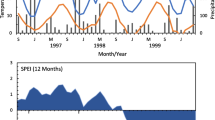Summary
The input of bird-disseminated seeds into four old fields of different structural complexity was examined. Seed input was greatest along the edges of fields. Significantly more seeds were found in a 13 year old field that had structurally complex vegetation, than in a 3-year-old field with a single layer of vegetation. The lower input into the latter field was a function of both low fruit availability and low structural complexity of the field. Similarly, more seeds were found in a 2-year-old field which had artificial structures, simulating saplings, placed in it than in an adjacent control field of the same age. The shape of the structures was not a significant factor in the input of seeds. Timing of seed deposition was correlated with fruit ripening times, relative nutritional value of the fruit and the movements of frugivorous birds. The input of bird-disseminated seeds into fields appears to be directly related to the structural complexity of the vegetation. Woody plants increase the structural complexity of the old fields and serve as recruitment foci for bird-disseminated seeds. Thus, seed deposition by birds influences vegetation pattern, and conversely, the presence of recruitment foci in the vegetation may influence bird dispersal patterns of bird-disseminated seeds.
Similar content being viewed by others
References
Auclair AN, Cottam G (1971) Dynamics of black cherry (Prunus serotina Ehrh.) in southern Wisconsin oak forests. Ecol Monogr 41:153–177
Baird JW (1980) The selection and use of fruit by birds in an eastern forest. Wilson Bull 92:63–73
Bard GE (1952) Secondary succession on the Piedmont of New Jersey. Ecol Monogr 22:195–215
Bazzaz FA (1968) Succession on abandoned fields in the Shownee Hills, Southern Illinois. Ecol 49:924–936
Barraz FA (1975) Plant species diversity in old field successional ecosystems in Southern Illinois. Ecol 56:485–488
Beckwith SL (1954) Ecological succession on abandoned farm lands and its relationship to wildlife management. Ecol Monogr 24:349–376
Biel F (1958) The climate of New Jersey In: Fink, SJ (ed) The Economy of New Jersey, Rutgers Univ Press New Brunswick p 53–98
Buell MF, Buell HF, Small JA, Siccama TG (1971) Invasion of trees in secondary succession on the New Jersey Piedmont. Bull Torrey Bot Club 98:67–74
Fleming TH, Heithaus ER (1981) Frugivorous bats, seed shadows, and the structure of tropical forests. Rep Bot Biotropica Vol 13 supp:45–53
Gleadow RM, Ashton DH (1981) Invasion by Pittosporum undulatum of the forests of Central Victoria. I Invasion patterns and plant morphology. Aust J Bot 29:705–720
Glyphis JP, Milton SF, Siegfied WR (1981) Dispersal of Acacia cyclops by birds. Oecologia 48:138–141
Hooper J, Bullington RA (1972) Invasion of woody plants in abandoned soil bank area of Pine Rock Preserve in Ogle County. Tran Ill State Acad Sci 65:58–67
Howe HF (1977) Bird activity and seed dispersal of a tropical wet forest tree. Ecol 58:539–550
Howe HF, Primack R (1974) Differential seed dispersal by birds of the tree Casearia nitida (Flacourtiaceae). Biotropica 7:278–283
Janzen DH, Miller GA, Hackforth-Jones J, Pond CM, Hooper K, Janos DP (1976) Two Costa Rican bat-generated seed shadows of Andira inermis (Leguminosae) Ecol 57:1068–1075
Keever C (1950) Causes of succession on old fields of the Piedmont North Carolina. Ecol Monogr 20:231–250
Livingston RB (1972) Influence of birds, stones and soil on the establishment of pasture juniper, Juniperus communis, and red cerdar, Juniperus virginiana, in New England pastures. Ecology 53:1141–1147
Marks PL (1974) The role of pin cherry (Prunus pensylvanica) in the maintenance of stability in northern hardwood ecosystems. Ecol Monogr 44:73–88
Martin AC, Zim HS, Nelson AL (1951) American wildlife and plants. McGraw-Hill New York
Pijl L van der (1972) Principles of dispersal in higher plants. Springer-Verlag New York
Ridley HN (1930) The dispersal of plants throughout the world. L Reeve nd Co Ltd Kent
Small JA, Buell MF, Buell HF, Siccama TG (1971) Old field succession on the New Jersey Piedmont: The first year. The William L Hutcheson Memorial Forest Bull 2:26–30
Smith AJ (1975) Invasion and ecesis of bird-disseminated woody plants in a temperate forest sere. Ecology 56:19–34
Smith CC (1940) Biotic and physiographic succession on abandoned eroded farmland. Ecol Monogr 10:421–484
Snedecor GW, Cochran WG (1974) Statistical methods. The Iowa State University Press Ames, Iowa
Stiles EW (1980) Patterns of fruit presentation and seed dispersal in bird-disseminated woody plants in the Eastern Deciduous Forest. Am Nat 116:670–688
Thompson JN, Willson MF (1979) Evolution of temperate fruit/bird interactions: Phenological strategies. Evolution 33:973–982
Ugolini FC (1964) Soil development on the red shale beds of New Jersey. William L Hutcheson Memorial Forest Bull 2:1–34
United States Weather Bureau (1959) Climates of the states New Jersey. United States Dept of Commerce Government Printing Office Washington, DC
Yarranton GA, Morrison RG (1974) Spatial dynamics of a primary succession: nucleation. J Ecol 62:417–428
Author information
Authors and Affiliations
Rights and permissions
About this article
Cite this article
McDonnell, M.J., Stiles, E.W. The structural complexity of old field vegetation and the recruitment of bird-dispersed plant species. Oecologia 56, 109–116 (1983). https://doi.org/10.1007/BF00378225
Received:
Issue Date:
DOI: https://doi.org/10.1007/BF00378225




